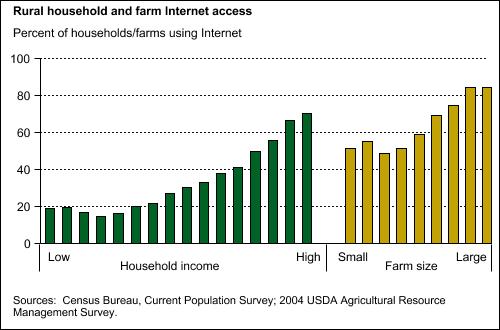Internet on the Range
- by Peter L. Stenberg and Mitch Morehart
- 2/1/2006
Over the last decade, the Internet has become a standard tool used in the workplace. Access to and use of the Internet has increased since the 1990s for all regions of the country, most types of workplaces, and all income groups. While many see the Internet as ubiquitous, it has not yet become universal. Rural areas lag urban areas in access to the Internet, and a gap is evident between farm and nonfarm workplaces.
According to data from the October 2003 Current Population Survey, 42 percent of all U.S. employees had access to the Internet at their workplace. Rural workers (31 percent) were less likely than urban workers (43 percent) to have access to the Internet. Among all employed persons, the likelihood of having access to the Internet rises with household income. More than 70 percent of workers with a household income greater than $150,000 had access to the Internet, but the percentage drops below 21 percent for workers with household incomes under $25,000. Within each household income group, rural workers were less likely than urban workers to have workplace Internet access.
In 2003, 60 percent of all U.S. households had a least one adult who used the Internet someplace, such as at work, school, home, or the library. The rate was 51 percent in rural households, compared with 62 percent in urban households. As would be expected given education’s role in the determination of income, Internet use is greater with higher educational attainment. For households where the primary breadwinner has a college degree, Internet use is 81 percent—82 percent for urban and 76 percent for rural households. For households where no adult has graduated from high school, the rate drops to 39 percent—40 percent for urban and 33 percent for rural households.
In rural areas, farms have been in the vanguard of Internet use in the workplace. According to data from USDA’s Agricultural Resource Management Survey, 56 percent of farms reported having computers with Internet access in 2004. Twenty percent of those respondents used the Internet to purchase farm-related items and 29 percent used it to purchase household items. Internet use varied somewhat by geographic location of the farm household, with farms in small towns having the lowest share with Internet access. Differences in Internet use among farm households by farm sales, however, were striking. Internet use ranged from 49 percent for farms with sales of $10,000 to $19,999 to 84 percent for the largest farms (gross sales of $500,000 or more). The largest farms also had the highest share of individuals using the Internet to make both farm and household purchases, mirroring the pattern of all U.S. households.
This article is drawn from:
- ARMS Farm Financial and Crop Production Practices. (n.d.). U.S. Department of Agriculture, Economic Research Service.
- Rural Economy & Population. (n.d.). U.S. Department of Agriculture, Economic Research Service.



